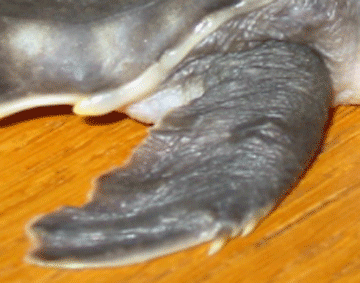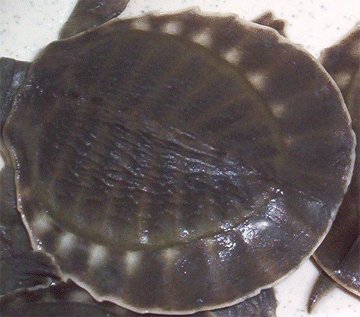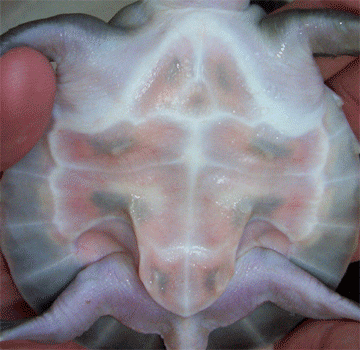Carettochelys insculpta (Ramsay, 1886)
Pig-nose Turtle / Fly River Turtle / Pitted Shell Turtle / Warradjan
Cryptodira -> Carettochelyidae -> Carettochelys -> Carettochelys insculpta
 |
Head
|
The head is relatively robust with the nostrils at the end of a prominent fleshy proboscis, which gave the species its name 'Pig-nose Turtle'. The top of the head is grey while the lower jaw is very light grey or even pink (in juveniles). There is a white streak right behind the eye. A dark grey spot may be located on the lower jaw (in some specimen this dark spot is missing). The jaws are big with a strong grip. The tongue is pink and fleshy. The eye has a black pupil and a black iris with a dark blue edge. |
|
 |
Fore limbs
|
The limbs are paddle-shaped and resemble those of marine turtles. There are two claws on each of the front limbs which are used to hold and direct the food so that it can be swallowed. The color of the limb is grey. Hatchlings have already well formed strong limbs that allow them to reach the water as soon as possible once they emerge from the nest. The strong fore limbs make Carettochelys insculpta an excellent swimmer. |
|
 |
Hind limbs
|
The hind limbs are also strongly webbed and are used for both paddling and steering.
"Prominent folds of skin extend laterally on each side from the undersurface of the tail across the thigh region and down the hind limbs". (Georges & Rose 1993) |
|
 |
Carapace
|
Instead of scutes, the carapace is covered with a leathery skin and is relatively deep. A median keel is present towards the rear of the carapace. "The peripheral bones are complete and well-developed, so there is no flexible shell margin". (Georges & Rose 1993). The color ranges from dark grey through olive-grey to brown. Hatchlings also posses a tuberculate median keel and a serrated margin on the sides of the carapace. The peripheral bones are visible due to their different color (see the photo) and there are white spots (7-8 on each side in line with the peripheral 'rays') located at the outer rim of the carapace. The white spots disappear as the specimen matures. |
|
 |
Plastron
|
"The plastron, although small, forms a continuous plate without even a median fontanelle. Several of the plastron elements are not rigidly ossified together, but rather have cartilaginous connections which allow a certain amount of flexibility". (Georges & Rose 1993). The plastron is light grey towards the edges while the rest of it is white. Hatchlings and juveniles tend to have a plastron pink colored. Little blood vessels can be seen just underneath the plastron's surface. |
|





